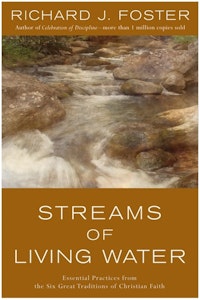 Excerpt from Streams of Living Water
Excerpt from Streams of Living Water
“Beautiful of soul.” Certainly this is one of the deepest descriptions of the Contemplative Stream, the prayer-filled life. But all of us are painfully aware of how far we fall short of that description. How do we become “beautiful of soul”? The devotional masters struggle to describe this process to us: “This divine, loving fire of contemplation … this burning of love … the fire and wound of this forceful love … this very fire of love … love aflame … the fire of divine love.”1 In fact, the two most common words used to describe the contemplative way of life are fire and love. Purging, purifying fire. Enveloping, comforting love. This is the stuff of the contemplative life.
Put simply, the contemplative life is the steady gaze of the soul upon the God who loves us. It is “an intimate sharing between friends,” to use the words of Teresa of Avila.2 Let me describe for you some of the contemplative life’s most fundamental characteristics and movements.3
Love. Through time and experience we sense a delicate but deepening love for God that feels more like a gift than an achievement. In the beginning this love is so quiet and unobtrusive that it is hardly perceptible. John of the Cross calls it a “secret and peaceful and loving inflow of God.”4 This is a great encouragement to us, for early in our prayer life — try as we might — we are unable to truly love God. This love comes little by little, and at first we experience a great deal of fluctuation in its intensity. High and low, hot and cold. In time, however, our love grows deeper, stronger, more steady.
Peace. At the same time, in slips a peace that cannot be analyzed or dissected — “a peace that passes understanding,” as Paul puts it (Phil. 4:7). This quiet rest, this firmness of life orientation, is not due to the absence of conflict or worry. In fact, it is not an absence at all, but rather a Presence. This peace is interrupted often by a multitude of distractions, especially in the beginning. But no matter — it is still there, and it is still real. And in time its quiet way wins over the chatter and clatter of our noisy hearts.
Delight. Another movement we begin to experience is delight. A very wise woman — one who had been through great hardship in her life — captured the essence of this quality for me when on one occasion she declared, “Fun ahead, saith the Lord!” There is pleasure, friendship, joy — deep joy. And playfulness. God laughs into our soul and our soul laughs back into God. John of the Cross calls it “the sweet and delightful life of love with God … that delightful and wondrous vision.”5 But it is not uninterrupted delight. We experience an ebb and flow, an exquisite delight mingled with a painful yearning.
Emptiness. Which brings us to an opposing, almost contradictory movement in the contemplative life: emptiness. At the very moment we are entering a loving delight, we are also pulled into intense longing, yearning, searching — searching and not finding. Well, there is a finding of sorts, but not a complete finding. Perhaps we could call it a dissatisfied satisfaction. John of the Cross calls it “a living thirst … [the] urgent longing of love.”6
Often the emptiness is a darkness as well. We experience Deus Absconditus, the God who is hidden from us. Dryness too — a Sahara of the heart. Throughout these experiences solitude is our welcome companion, for we are learning to be alone with the Alone. Please understand, this emptiness, this darkness, this dryness is itself prayer. It is a heavenly communion of an ascetic sort. While delight is a feasting, emptiness is a fasting, and both are needed for the growth of the soul.
Fire. Still another reality we experience as we grow in the contemplative life is fire. Not literal fire, of course, but real fire nonetheless — in some ways more real than literal fire. The initial movement of love now intensifies, becoming a steady, flaming passion. Anything that causes distance or separation from God — disobedience or perhaps mere neglect — is painful in the extreme. So we feel, and even welcome, the purifying fire of God’s love burning out the dross: all stubbornness, all hate, all grasping need for self-promotion. And as the self-sins are burned away, the seeds of universal love blossom and flower.
Wisdom. This leads to a still deeper movement of the Spirit: wisdom. No sterile intellectualism or impersonal awareness, this is a knowing and inflowing of God himself. We are filled with “the knowledge of the glory of the LORD, as the waters cover the sea” (Hab. 2:14). We know as we are known. We enter that eternal life which is to “know you, the only true God, and Jesus Christ whom you have sent” (John 17:3b). Prayer turns into the deepening self-communication of the Trinity, a self-communication we are privileged to listen in on and even participate in.
Transformation. Through it all, God gradually and slowly “captures” the inner faculties: first the heart and the will, then the mind, the imagination, and the passions. The result is the transformation of the entire personality into the likeness of Christ. More and more and more we take on his habits, feelings, hopes, faith, and love.
Related Podcast
Excerpted from Streams of Living Water by Richard J. Foster, published by HarperOne. Copyright Richard J. Foster. Used with permission.
[1] These phrases are taken from many sources, including John of the Cross, Blaise Pascal, and Richard Rolle.
[2] The Life: The Collected Works of St. Teresa, vol. 1, trans. Kieran Kavanaugh and Otilio Rodriquez (Washington, DC: ICS Publications, 1976), chap. 8, no. 5, p. 67, as cited in Thomas Dubay, Fire Within: St. Teresa of Avila, St. John of the Cross, and the Gospel On Prayer (San Francisco: Ignatius, 1989), p. 58.
[3] Those who have read the great masters of contemplative prayer will recognize that I am describing in my own way the ancient triad of illumination, purgation, and union. Some of the items in this list were suggested to me by Thomas Dubay in his book Fire Within. This book is a good resource for a full discussion of these matters, especially his chapter entitled “What is Contemplation?”
[4] As quoted in Dubay, Fire Within, p. 61
[5] As quoted in Dubay, Fire Within, p. 62
[6] As quoted in Dubay, Fire Within, p. 62
Text First Published October 1998


